Financial Planning Assignment: Insurance, Healthcare and Risk Analysis
VerifiedAdded on 2022/08/19
|5
|776
|13
Homework Assignment
AI Summary
This assignment addresses key concepts in financial planning, providing solutions to questions about insurance and risk management. The first answer differentiates between pure and speculative risk, highlighting the insurability of pure risk. The second answer outlines the steps for effective insurance planning, from identifying to administering risk. The third answer offers practical advice on reducing personal healthcare costs, including seeking generic medicines and planning for emergencies. Finally, the assignment details the types of health insurance coverage, distinguishing between indemnity and defined benefit plans, and listing examples within each category. The solutions are supported by relevant references to academic literature.
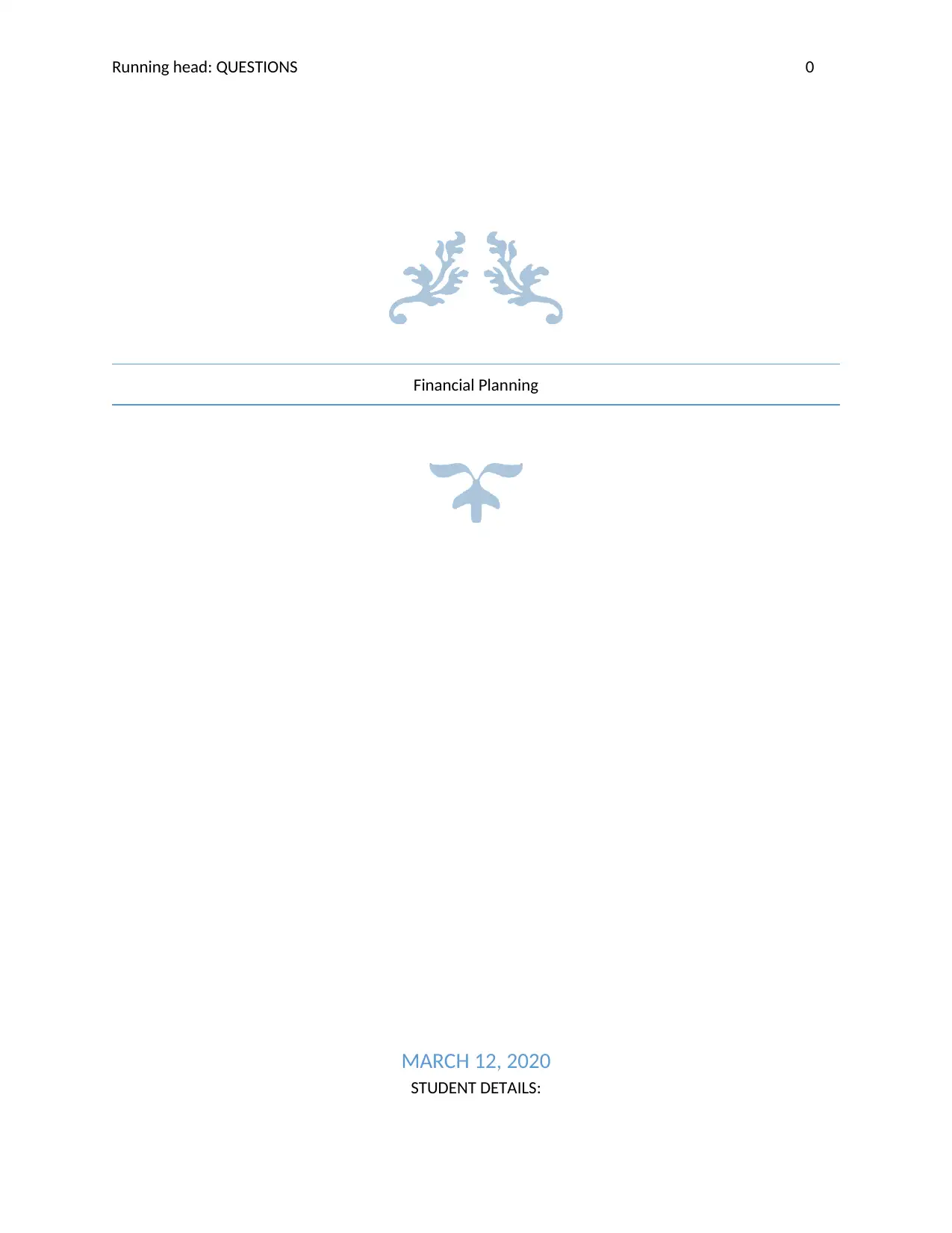
Running head: QUESTIONS 0
Financial Planning
MARCH 12, 2020
STUDENT DETAILS:
Financial Planning
MARCH 12, 2020
STUDENT DETAILS:
Paraphrase This Document
Need a fresh take? Get an instant paraphrase of this document with our AI Paraphraser
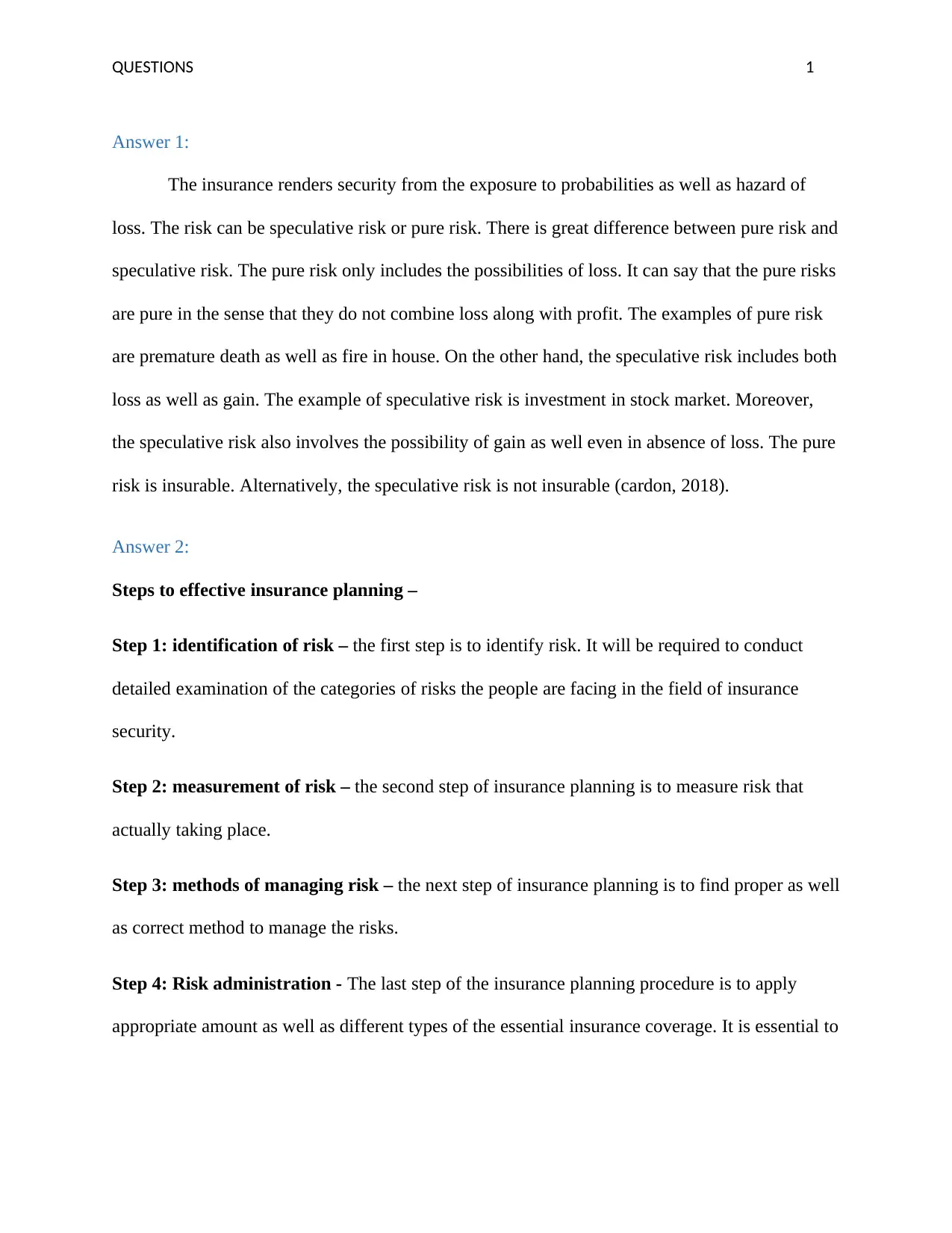
QUESTIONS 1
Answer 1:
The insurance renders security from the exposure to probabilities as well as hazard of
loss. The risk can be speculative risk or pure risk. There is great difference between pure risk and
speculative risk. The pure risk only includes the possibilities of loss. It can say that the pure risks
are pure in the sense that they do not combine loss along with profit. The examples of pure risk
are premature death as well as fire in house. On the other hand, the speculative risk includes both
loss as well as gain. The example of speculative risk is investment in stock market. Moreover,
the speculative risk also involves the possibility of gain as well even in absence of loss. The pure
risk is insurable. Alternatively, the speculative risk is not insurable (cardon, 2018).
Answer 2:
Steps to effective insurance planning –
Step 1: identification of risk – the first step is to identify risk. It will be required to conduct
detailed examination of the categories of risks the people are facing in the field of insurance
security.
Step 2: measurement of risk – the second step of insurance planning is to measure risk that
actually taking place.
Step 3: methods of managing risk – the next step of insurance planning is to find proper as well
as correct method to manage the risks.
Step 4: Risk administration - The last step of the insurance planning procedure is to apply
appropriate amount as well as different types of the essential insurance coverage. It is essential to
Answer 1:
The insurance renders security from the exposure to probabilities as well as hazard of
loss. The risk can be speculative risk or pure risk. There is great difference between pure risk and
speculative risk. The pure risk only includes the possibilities of loss. It can say that the pure risks
are pure in the sense that they do not combine loss along with profit. The examples of pure risk
are premature death as well as fire in house. On the other hand, the speculative risk includes both
loss as well as gain. The example of speculative risk is investment in stock market. Moreover,
the speculative risk also involves the possibility of gain as well even in absence of loss. The pure
risk is insurable. Alternatively, the speculative risk is not insurable (cardon, 2018).
Answer 2:
Steps to effective insurance planning –
Step 1: identification of risk – the first step is to identify risk. It will be required to conduct
detailed examination of the categories of risks the people are facing in the field of insurance
security.
Step 2: measurement of risk – the second step of insurance planning is to measure risk that
actually taking place.
Step 3: methods of managing risk – the next step of insurance planning is to find proper as well
as correct method to manage the risks.
Step 4: Risk administration - The last step of the insurance planning procedure is to apply
appropriate amount as well as different types of the essential insurance coverage. It is essential to
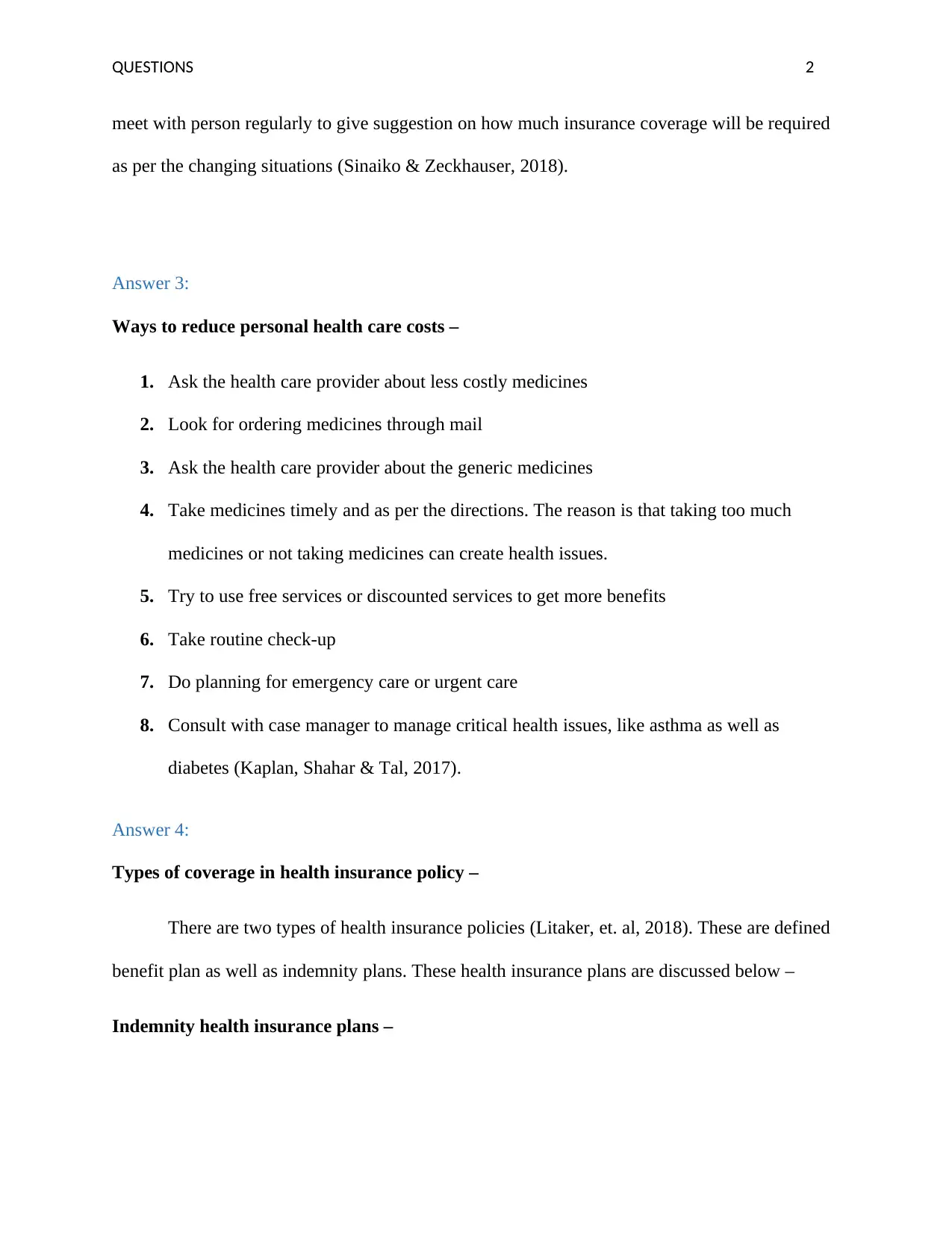
QUESTIONS 2
meet with person regularly to give suggestion on how much insurance coverage will be required
as per the changing situations (Sinaiko & Zeckhauser, 2018).
Answer 3:
Ways to reduce personal health care costs –
1. Ask the health care provider about less costly medicines
2. Look for ordering medicines through mail
3. Ask the health care provider about the generic medicines
4. Take medicines timely and as per the directions. The reason is that taking too much
medicines or not taking medicines can create health issues.
5. Try to use free services or discounted services to get more benefits
6. Take routine check-up
7. Do planning for emergency care or urgent care
8. Consult with case manager to manage critical health issues, like asthma as well as
diabetes (Kaplan, Shahar & Tal, 2017).
Answer 4:
Types of coverage in health insurance policy –
There are two types of health insurance policies (Litaker, et. al, 2018). These are defined
benefit plan as well as indemnity plans. These health insurance plans are discussed below –
Indemnity health insurance plans –
meet with person regularly to give suggestion on how much insurance coverage will be required
as per the changing situations (Sinaiko & Zeckhauser, 2018).
Answer 3:
Ways to reduce personal health care costs –
1. Ask the health care provider about less costly medicines
2. Look for ordering medicines through mail
3. Ask the health care provider about the generic medicines
4. Take medicines timely and as per the directions. The reason is that taking too much
medicines or not taking medicines can create health issues.
5. Try to use free services or discounted services to get more benefits
6. Take routine check-up
7. Do planning for emergency care or urgent care
8. Consult with case manager to manage critical health issues, like asthma as well as
diabetes (Kaplan, Shahar & Tal, 2017).
Answer 4:
Types of coverage in health insurance policy –
There are two types of health insurance policies (Litaker, et. al, 2018). These are defined
benefit plan as well as indemnity plans. These health insurance plans are discussed below –
Indemnity health insurance plans –
⊘ This is a preview!⊘
Do you want full access?
Subscribe today to unlock all pages.

Trusted by 1+ million students worldwide
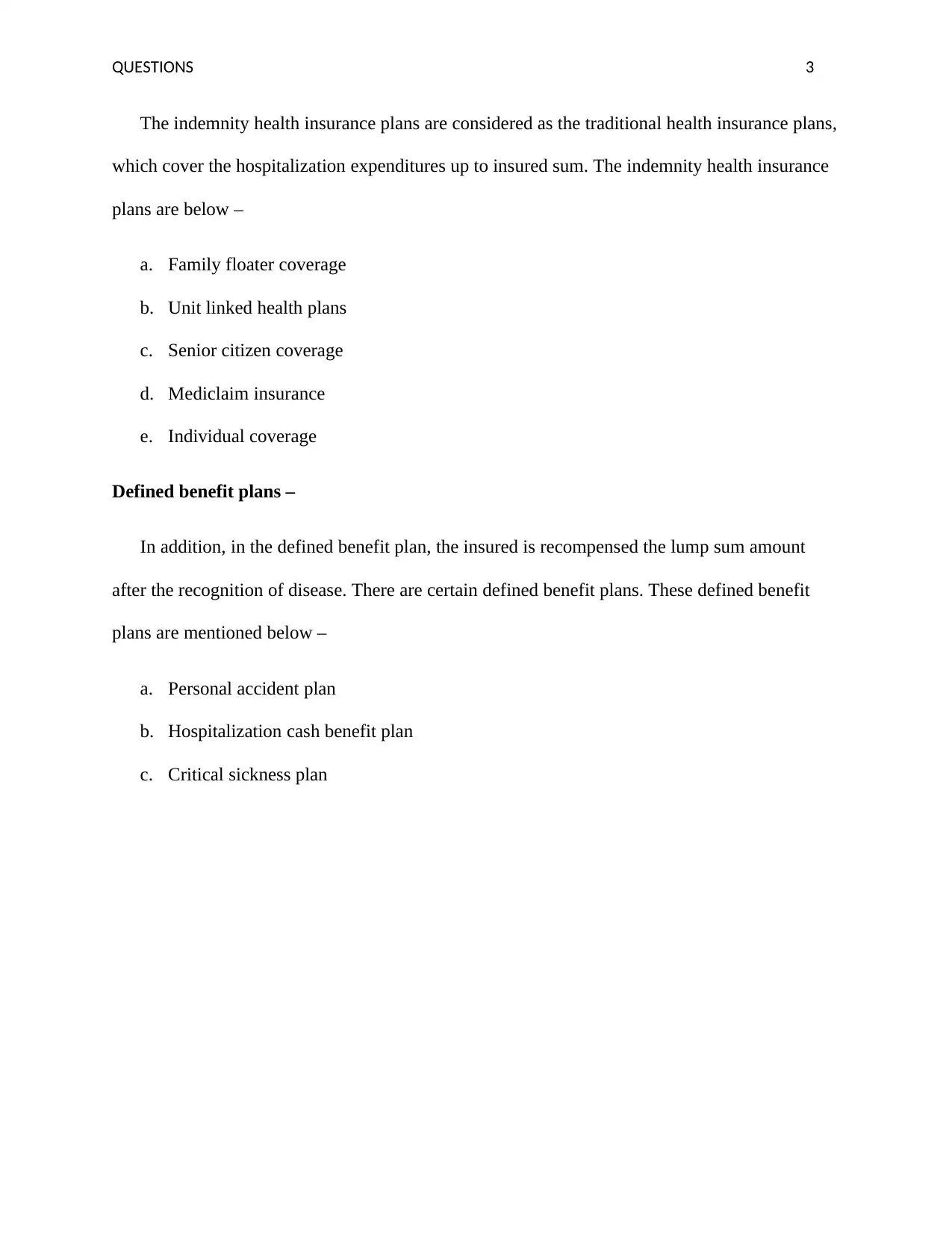
QUESTIONS 3
The indemnity health insurance plans are considered as the traditional health insurance plans,
which cover the hospitalization expenditures up to insured sum. The indemnity health insurance
plans are below –
a. Family floater coverage
b. Unit linked health plans
c. Senior citizen coverage
d. Mediclaim insurance
e. Individual coverage
Defined benefit plans –
In addition, in the defined benefit plan, the insured is recompensed the lump sum amount
after the recognition of disease. There are certain defined benefit plans. These defined benefit
plans are mentioned below –
a. Personal accident plan
b. Hospitalization cash benefit plan
c. Critical sickness plan
The indemnity health insurance plans are considered as the traditional health insurance plans,
which cover the hospitalization expenditures up to insured sum. The indemnity health insurance
plans are below –
a. Family floater coverage
b. Unit linked health plans
c. Senior citizen coverage
d. Mediclaim insurance
e. Individual coverage
Defined benefit plans –
In addition, in the defined benefit plan, the insured is recompensed the lump sum amount
after the recognition of disease. There are certain defined benefit plans. These defined benefit
plans are mentioned below –
a. Personal accident plan
b. Hospitalization cash benefit plan
c. Critical sickness plan
Paraphrase This Document
Need a fresh take? Get an instant paraphrase of this document with our AI Paraphraser
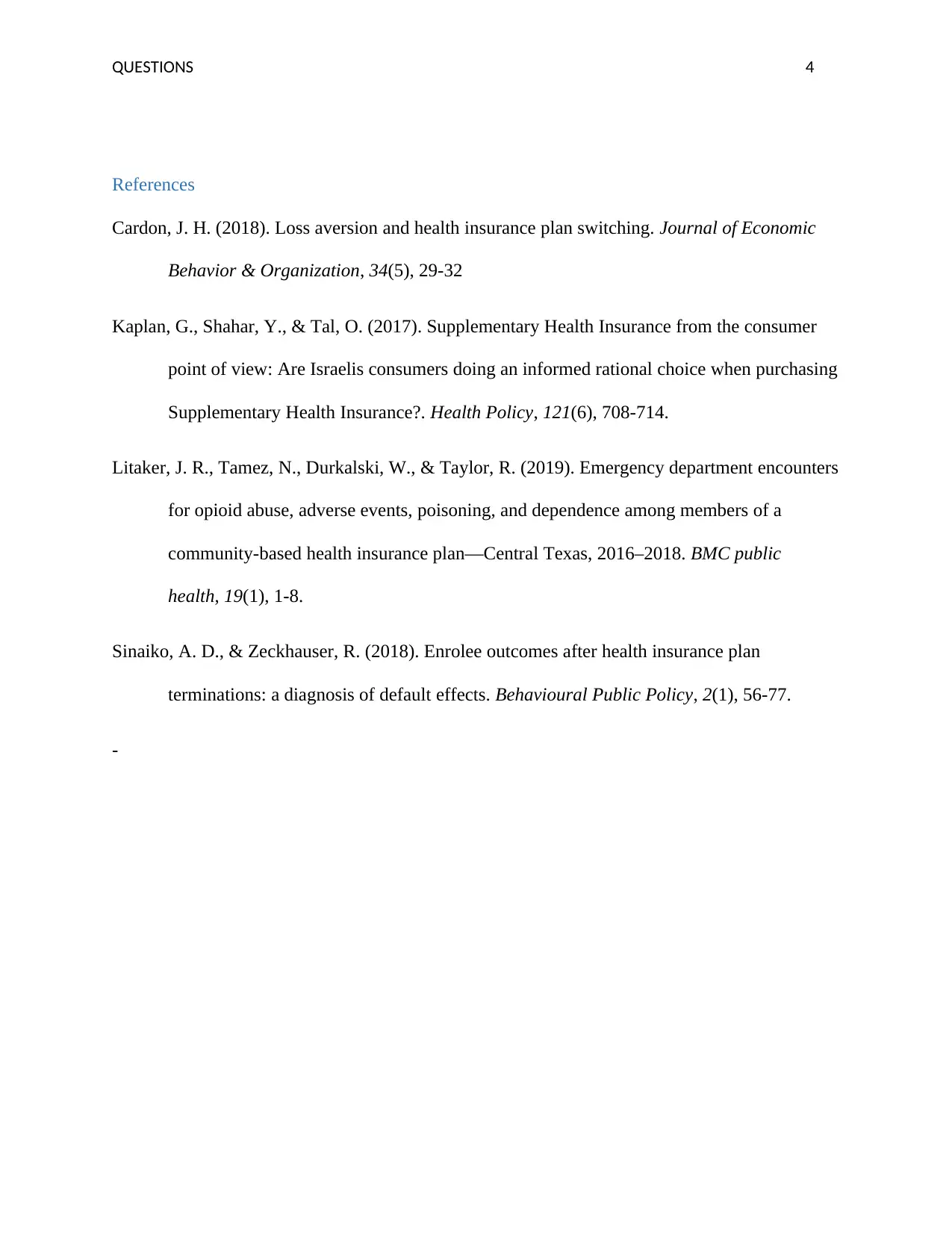
QUESTIONS 4
References
Cardon, J. H. (2018). Loss aversion and health insurance plan switching. Journal of Economic
Behavior & Organization, 34(5), 29-32
Kaplan, G., Shahar, Y., & Tal, O. (2017). Supplementary Health Insurance from the consumer
point of view: Are Israelis consumers doing an informed rational choice when purchasing
Supplementary Health Insurance?. Health Policy, 121(6), 708-714.
Litaker, J. R., Tamez, N., Durkalski, W., & Taylor, R. (2019). Emergency department encounters
for opioid abuse, adverse events, poisoning, and dependence among members of a
community-based health insurance plan—Central Texas, 2016–2018. BMC public
health, 19(1), 1-8.
Sinaiko, A. D., & Zeckhauser, R. (2018). Enrolee outcomes after health insurance plan
terminations: a diagnosis of default effects. Behavioural Public Policy, 2(1), 56-77.
-
References
Cardon, J. H. (2018). Loss aversion and health insurance plan switching. Journal of Economic
Behavior & Organization, 34(5), 29-32
Kaplan, G., Shahar, Y., & Tal, O. (2017). Supplementary Health Insurance from the consumer
point of view: Are Israelis consumers doing an informed rational choice when purchasing
Supplementary Health Insurance?. Health Policy, 121(6), 708-714.
Litaker, J. R., Tamez, N., Durkalski, W., & Taylor, R. (2019). Emergency department encounters
for opioid abuse, adverse events, poisoning, and dependence among members of a
community-based health insurance plan—Central Texas, 2016–2018. BMC public
health, 19(1), 1-8.
Sinaiko, A. D., & Zeckhauser, R. (2018). Enrolee outcomes after health insurance plan
terminations: a diagnosis of default effects. Behavioural Public Policy, 2(1), 56-77.
-
1 out of 5
Related Documents
Your All-in-One AI-Powered Toolkit for Academic Success.
+13062052269
info@desklib.com
Available 24*7 on WhatsApp / Email
![[object Object]](/_next/static/media/star-bottom.7253800d.svg)
Unlock your academic potential
Copyright © 2020–2025 A2Z Services. All Rights Reserved. Developed and managed by ZUCOL.





